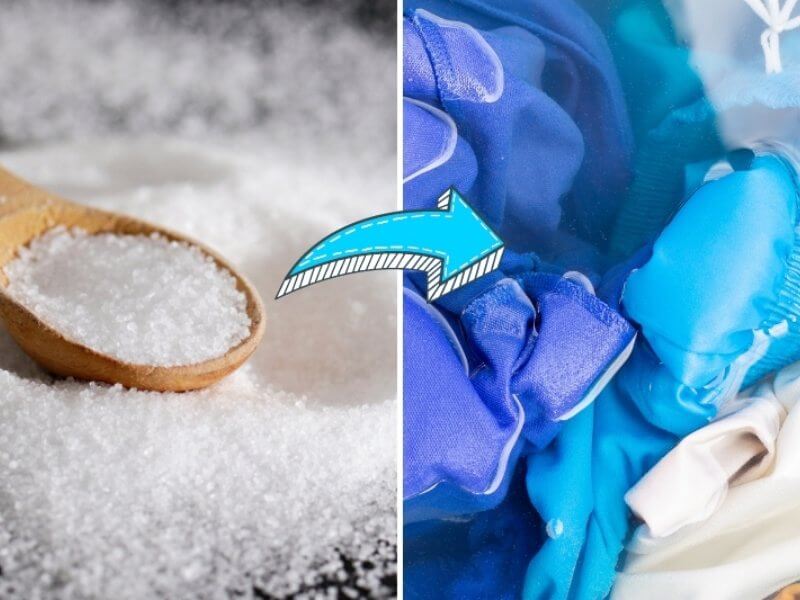How to make thick T Shirts feel worn? If you love the durability of thick T-shirts but hate their stiff, rough texture—don’t worry! You don’t have to wait years to achieve that soft, worn-in feel. With these 7 methods, tips, and tricks below, you can transform any thick T-shirt into the perfect, well-worn favorite in no time. So what are you waiting for? Let’s discover now with Yes T-Shirt!
How To Make Thick T-Shirts Feel Worn? 7 Common Ways To Follow
1. Saltwater Soak – The Natural Way to Break Down Stiff Fibers
Saltwater offers one of the best ways to soften a thick T-shirt. This technique imitates the effect of many washes softening the stiff fibers in the fabric.
What You Need:
- ½ to 1 cup of salt (based on the shirt’s stiffness)
- A big bucket or sink
- Warm water
How To Do It:
- Fill a bucket or sink with warm water and add salt.
- Mix until the salt dissolves.
- Put your T-shirt in, making sure the water soaks the fabric.
- Let it sit for at least 24 hours.
- After that, machine wash on a gentle cycle with mild detergent.
Pro Tip:
- For extra softness, leave it for up to 48 hours.
- After soaking, rinse the shirt well with cold water. And finally, wash it in the machine with mild detergent on a normal cycle.
- Following the salt solution with one or two wash cycles and drying sessions enhances the effectiveness of this treatment. This method is especially effective with vintage T-shirt designs.

Saltwater soak is the best way to handle your shirt naturally – Source: Inthewash.com
2. High Heat Tumble Dry – Speed Up the Aging Process
A dryer serves as an excellent alternative for those who prefer not to wait for the salt solution effects. The fabric will become softer and much speedier through the heat application and friction across its surface and intentional movements.
How to Do It:
- Warm water during T-shirt washing will soften the fabric fibers.
- To soften the shirt, place dried balls or tennis balls inside the dryer with your garment to smooth out the stiffness.
- The dry setting should operate at a high temperature for 30 to 40
- After removing the shirt, you should stretch it out manually before testing its softness. If needed, repeat the process.
Pro Tips:
- You can use fabric softener sheets to enhance the stretching method, but they are unnecessary.
- An unrolled, moist towel placed inside the dryer with your T-shirt will generate steam and add extra softness to the clothing material.
- Remove your shirt when it shows no more than wetness to avoid dimensional reduction.

You can also dry your T-shirt with high heat – Source: Freeload.com
3. Wear It Often – The Best Method for Natural Softness
The most old-school method? Just wear it! The combination of your natural movements, sweat, and regular washing will naturally open the fabric fibers.
How to do it:
- Put the rough shirt on while staying indoors during the first period of stiffness. The more movement, the better.
- Regular washing is best for your shirt, yet use gentle detergents that do not dry up the fabric. An enzyme-based detergent provides gentle cleaning solutions when compared to other options.
- When the shirt is lightly moistened, try rolling and twisting it to ease the fibers.
- Sleep in it! Through body heat and friction with a sheet, the material naturally softens.
Pro Tips:
- Layer the shirt under a hoodie or jacket to help stretch and loosen it up without discomfort.
- If you have multiple thick shirts, rotate them; each wear will help soften the fabric over time.
- Combine this method with saltwater soaking or tumble drying for the fastest results.

Wear your T-shirt more regularly to soften it. Source: undershirtguy.com
4. Gentle Distressing: Making It Look and Feel Naturally Worn
As you know, proper techniques allow you to create the appearance of years-accumulated wear on recently bought t-shirts.
What You’ll Need:
- Fine-grit sandpaper (220-400 grit)
- A pumice stone or dry scouring pad
- A cheese grater (optional, for heavier distressing)
- To achieve this result, you should use a brush that was formerly part of a toothbrush.
How to do it:
- Apply sandpaper softly to the crucial areas that tend to weaken first, including the shirt collar, sleeve hems, and bottom of the garment. A gently worn appearance emerges from these techniques without any excessive wear.
- The fabric surface softens by using either a pumice stone or scouring pad. Work in round motions with gentle pressure to avoid damaging the fabric.
- To achieve maximum authenticity in your look, use a toothbrush to work on seam and edge fibers to break them down.
Pro Tips:
- When achieving serious vintage wear and tear in specific areas, add threadbare effects by using a cheese grater on the pocket region and the shoulder section.

Distress your T-shirt in many ways – Source: shirtspace.com
5. Fabric Softener: Loosening Stiff Fibers
You can reduce thick cotton fabric’s stiffness by placing it in a bath with fabric softener.
What You’ll Need:
- Liquid fabric softener (Downy or any good-quality brand)
- Warm water
- A large bucket or sink
How to do it:
- A large bucket should hold warm water, and you should add 1/4 cup of fabric softener to it and mix well.
- The t-shirt requires total submersion in water until it becomes completely wet.
- The item needs to soak for 6-12 hours, but an overnight soak gives the best outcome. The fabric requires a longer soaking time to become progressively softer.
- After a cold water rinse, you should dry your garment naturally or use a low-heat tumble dryer to make it softer.
Pro Tip: If you want an ultra-soft feel, repeat this process once or twice more. You can also add a tablespoon of white vinegar to the mix to help break down tough fibers.

Consider your fabric softener – Source: Readsimple.com
6. Baking Soda and Vinegar
Baking soda, paired with vinegar, comes as a fabric softening agent to remove chemical processes involved in manufacturing cloth stiffness.
What You’ll Need:
- ½ cup of baking soda
- ½ cup of white vinegar
- A washing machine
How to do it:
- Put baking soda into your washing machine drum first before introducing your T-shirt.
- Wash the garment with moderate heat in combination with a delicate liquid detergent.
- The rinse cycle requires you to add white vinegar into the fabric softener compartment either through the compartment or by manual addition.
- The drying process should take place in the tumble dryer at low heat or through natural air drying methods.
Pro Tip: This basic method serves as an excellent technique to reduce fabric stiffness and discharge unwanted chemical scents in new shirts.

Banking soda might be your first Source: Thespruce.com
FAQs
1. Does Hot Water Stretch T-Shirts?
Hot water does not expand clothing because it tends to reduce fabric dimensions by relaxing cotton, wool, and linen fibers, which results in garment shortening.
2. Does 100% Cotton Stretch Over Time?
The stretchability of 100% cotton fabrics is minimal because the material expands naturally through regular use, but the effect is not as strong as elastic-containing textiles. Cotton fibers stretch over time, so clothing items around knees or seats will expand slightly through extended use.
3. Does Washing A T-Shirt Multiple Times Help Soften It?
Multiple washing rounds of a T-shirt lead to fiber breakdown through agitation and water exposure, resulting in fabric softening since cotton materials benefit the most from this process.
Conclusion
We covered you on how to make thick T Shirts feel worn. Thick T-shirts never need to maintain their stiff and uncomfortable characteristics beyond an endless period. To create soft, comfortable clothing, you should apply saltwater soaking, then tumble dry at high heat, followed by using fabric softeners.
Ready to upgrade your wardrobe with premium-quality tees that feel amazing from day one? Visit Yestshirt.com and find the perfect fit for your style today!










